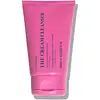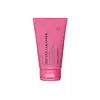What's inside
What's inside
 Key Ingredients
Key Ingredients

 Benefits
Benefits

 Concerns
Concerns

 Ingredients Side-by-side
Ingredients Side-by-side

Water
Skin ConditioningCaprylic/Capric Triglyceride
MaskingSimmondsia Chinensis Seed Oil
EmollientSqualane
EmollientPropanediol
SolventGlycerin
HumectantGlyceryl Stearate
EmollientPEG-100 Stearate
Cetearyl Alcohol
EmollientPhenoxyethanol
PreservativeJojoba Oil/Macadamia Seed Oil Esters
Skin ConditioningBetaine
HumectantCarbomer
Emulsion StabilisingHydroxyacetophenone
Antioxidant1,2-Hexanediol
Skin ConditioningCaprylyl Glycol
EmollientParfum
MaskingSodium PCA
HumectantSodium Hydroxide
BufferingXanthan Gum
EmulsifyingTetrasodium Glutamate Diacetate
Squalene
EmollientEthylhexylglycerin
Skin ConditioningSodium Lactate
BufferingHelianthus Annuus Seed Oil
EmollientPCA
HumectantCitric Acid
BufferingBiosaccharide Gum-1
HumectantSerine
MaskingAlanine
MaskingPhytosteryl Macadamiate
Skin ConditioningGlycine
BufferingGlutamic Acid
HumectantRosmarinus Officinalis Leaf Extract
AntimicrobialGlycine Hcl
BufferingThreonine
Arginine
MaskingPhytosterols
Skin ConditioningTocopherol
AntioxidantProline
Skin ConditioningTrisodium EDTA
Water, Caprylic/Capric Triglyceride, Simmondsia Chinensis Seed Oil, Squalane, Propanediol, Glycerin, Glyceryl Stearate, PEG-100 Stearate, Cetearyl Alcohol, Phenoxyethanol, Jojoba Oil/Macadamia Seed Oil Esters, Betaine, Carbomer, Hydroxyacetophenone, 1,2-Hexanediol, Caprylyl Glycol, Parfum, Sodium PCA, Sodium Hydroxide, Xanthan Gum, Tetrasodium Glutamate Diacetate, Squalene, Ethylhexylglycerin, Sodium Lactate, Helianthus Annuus Seed Oil, PCA, Citric Acid, Biosaccharide Gum-1, Serine, Alanine, Phytosteryl Macadamiate, Glycine, Glutamic Acid, Rosmarinus Officinalis Leaf Extract, Glycine Hcl, Threonine, Arginine, Phytosterols, Tocopherol, Proline, Trisodium EDTA
Helianthus Annuus Seed Oil
EmollientGlycerin
HumectantC9-12 Alkane
SolventCaprylic/Capric Triglyceride
MaskingVitis Vinifera Seed Oil
EmollientPersea Gratissima Oil
Skin ConditioningSimmondsia Chinensis Seed Oil
EmollientCoco-Caprylate/Caprate
EmollientWater
Skin ConditioningPropanediol
SolventSucrose Stearate
EmollientArgania Spinosa Kernel Oil
EmollientRosa Canina Fruit Oil
EmollientZingiber Officinale Root Extract
MaskingBisabolol
Masking1,2-Hexanediol
Skin ConditioningParfum
MaskingO-Cymen-5-Ol
AntimicrobialTocopheryl Acetate
AntioxidantCaprylhydroxamic Acid
Sucrose Palmitate
EmollientCitrus Aurantium Peel Oil
Citrus Limon Peel Oil
MaskingJuniperus Virginiana Oil
MaskingLimonene
PerfumingTetramethyl Acetyloctahydronaphthalenes
MaskingHelianthus Annuus Seed Oil, Glycerin, C9-12 Alkane, Caprylic/Capric Triglyceride, Vitis Vinifera Seed Oil, Persea Gratissima Oil, Simmondsia Chinensis Seed Oil, Coco-Caprylate/Caprate, Water, Propanediol, Sucrose Stearate, Argania Spinosa Kernel Oil, Rosa Canina Fruit Oil, Zingiber Officinale Root Extract, Bisabolol, 1,2-Hexanediol, Parfum, O-Cymen-5-Ol, Tocopheryl Acetate, Caprylhydroxamic Acid, Sucrose Palmitate, Citrus Aurantium Peel Oil, Citrus Limon Peel Oil, Juniperus Virginiana Oil, Limonene, Tetramethyl Acetyloctahydronaphthalenes
 Reviews
Reviews

Ingredients Explained
These ingredients are found in both products.
Ingredients higher up in an ingredient list are typically present in a larger amount.
1,2-Hexanediol is a synthetic liquid and another multi-functional powerhouse.
It is a:
- Humectant, drawing moisture into the skin
- Emollient, helping to soften skin
- Solvent, dispersing and stabilizing formulas
- Preservative booster, enhancing the antimicrobial activity of other preservatives
This ingredient is an emollient, solvent, and texture enhancer. It is considered a skin-softener by helping the skin prevent moisture loss.
It helps thicken a product's formula and makes it easier to spread by dissolving clumping compounds.
Caprylic Triglyceride is made by combining glycerin with coconut oil, forming a clear liquid.
While there is an assumption Caprylic Triglyceride can clog pores due to it being derived from coconut oil, there is no research supporting this.
Learn more about Caprylic/Capric TriglycerideGlycerin is already naturally found in your skin. It helps moisturize and protect your skin.
A study from 2016 found glycerin to be more effective as a humectant than AHAs and hyaluronic acid.
As a humectant, it helps the skin stay hydrated by pulling moisture to your skin. The low molecular weight of glycerin allows it to pull moisture into the deeper layers of your skin.
Hydrated skin improves your skin barrier; Your skin barrier helps protect against irritants and bacteria.
Glycerin has also been found to have antimicrobial and antiviral properties. Due to these properties, glycerin is often used in wound and burn treatments.
In cosmetics, glycerin is usually derived from plants such as soybean or palm. However, it can also be sourced from animals, such as tallow or animal fat.
This ingredient is organic, colorless, odorless, and non-toxic.
Glycerin is the name for this ingredient in American English. British English uses Glycerol/Glycerine.
Learn more about GlycerinHelianthus Annuus Seed Oil is the oil derived from the seeds of a Sunflower. Sunflower seed oil is non-fragrant. It is an emollient, meaning it helps to soften the skin.
Sunflower seed oil contains many fatty acids. The fatty acids found in sunflower seeds include (from highest amount to least): linoleic acid, myristic acid, palmitic acid, stearic acid, arachidic acid, oleic acid, and linolenic acid.
These fatty acids help the skin create ceramides. Ceramides play a role in repairing the skin barrier.
Helianthus Annuus Seed Oil helps moisturize the skin. This in turn helps the skin look more rejuvenated and smoother.
Sunflowers are rich in vitamin E.
Historians believe Indigenous cultures of North America domesticated sunflowers before corn. Thus they relied on sunflower oil for a variety of uses. One such use is moisturizing skin and hair.
Sunflower seed oil may not be fungal acne safe. We recommend speaking with a professional if you have any concerns.
Learn more about Helianthus Annuus Seed OilParfum is a catch-all term for an ingredient or more that is used to give a scent to products.
Also called "fragrance", this ingredient can be a blend of hundreds of chemicals or plant oils. This means every product with "fragrance" or "parfum" in the ingredients list is a different mixture.
For instance, Habanolide is a proprietary trade name for a specific aroma chemical. When used as a fragrance ingredient in cosmetics, most aroma chemicals fall under the broad labeling category of “FRAGRANCE” or “PARFUM” according to EU and US regulations.
The term 'parfum' or 'fragrance' is not regulated in many countries. In many cases, it is up to the brand to define this term.
For instance, many brands choose to label themselves as "fragrance-free" because they are not using synthetic fragrances. However, their products may still contain ingredients such as essential oils that are considered a fragrance by INCI standards.
One example is Calendula flower extract. Calendula is an essential oil that still imparts a scent or 'fragrance'.
Depending on the blend, the ingredients in the mixture can cause allergies and sensitivities on the skin. Some ingredients that are known EU allergens include linalool and citronellol.
Parfum can also be used to mask or cover an unpleasant scent.
The bottom line is: not all fragrances/parfum/ingredients are created equally. If you are worried about fragrances, we recommend taking a closer look at an ingredient. And of course, we always recommend speaking with a professional.
Learn more about ParfumPropanediol is an all-star ingredient. It softens, hydrates, and smooths the skin.
It’s often used to:
Propanediol is not likely to cause sensitivity and considered safe to use. It is derived from corn or petroleum with a clear color and no scent.
Learn more about PropanediolThis oil comes from the seeds of the desert shrub called Jojoba. It is more commonly known as jojoba oil, a non-comedogenic oil.
Jojoba oil does not contain fragrance and has many fatty-acids, making it a great soothing ingredient.
It also contains Vitamin E, a great moisturizing ingredient. Vitamin E is also an antioxidant and protects your skin against oxidative damage.
This ingredient humectant properties, meaning it helps draw moisture from the air. This helps keep your skin hydrated.
While jojoba has antibacterial properties, it is only able to kill some strains of bacteria.
Studies also show it helps in wound healing. In fact, Indigenous cultures have used jojoba as a moisturizer and to help treat burns for centuries.
Fun fact: Jojoba oil similar to natural human skin sebum, so it has a great effect on dry skin. It is also promising with helping to regulate sebum production.
Due to its fatty acid content, Jojoba oil may not be fungal acne safe. We recommend speaking with a professional if you have any concerns.
Learn more about Simmondsia Chinensis Seed OilWater. It's the most common cosmetic ingredient of all. You'll usually see it at the top of ingredient lists, meaning that it makes up the largest part of the product.
So why is it so popular? Water most often acts as a solvent - this means that it helps dissolve other ingredients into the formulation.
You'll also recognize water as that liquid we all need to stay alive. If you see this, drink a glass of water. Stay hydrated!
Learn more about Water